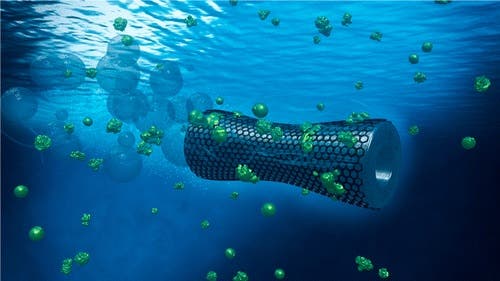All over the world, industrial processes release tonnes and tonnes of heavy metals in wastewaters. Cleaning up after them can be arduous, expensive and, well, just not worth it most of the time. A new solution proposed by researchers in Germany and Spain is so elegant and effective that it might revolutionise water purification. They suggest that a swarm of microbots, each no bigger than a strand of hair, could remove 95% of polluting heavy metals from water in less than an hour. These microbots can be then cleaned and prepared for re-use multiple times, thus closing the loop.

llustration of a self-propelled graphene oxide-based microbot for removing lead from wastewater. Credit: Vilela, et al. ©2016 American Chemical Society
“This work is a step toward the development of smart remediation system where we can target and remove traces of pollutant without producing an additional contamination,” said coauthor Samuel Sánchez, at the Max-Planck Institute for Intelligent Systems in Stuttgart, Germany;
In the new study, the researchers focused specifically on removing lead from wastewater by designing tube-shaped microbots with three functional layers.
The design is quite simple but ingenious. Each tube-shaped microbot consists of three layers. The outer layer is made of graphene oxide that absorbs the lead from the water. The middle one, made of nickel, is what makes the microbot ferromagnetic. This way, an external magnetic field can both direct the bots’ movements and retrieve them once their job is done. The inner layer is made of platinum and allows the microbots to self-propel themselves through the water. You have to add hydrogen peroxide first to the wastewater. When the platinum reacts with the hydrogen peroxide, oxygen microbubbles are created and ejected through the back of the microbot. This creates pressure which moves the microbot forward.
It’s all done without moving parts — just chemistry and magnetism. You can see some in action in the video below.
The same magnetic field collects the microbots from the wastewater once their mission is over. These are then treated with an acidic solution to remove the lead.
For now, these contraptions are designed for removing lead, but it can be tuned for other heavy metals like mercury (Hg), cadmium (Cd), arsenic (As), chromium (Cr), thallium (Tl).
“We plan to extend the microbots to other contaminants, and also importantly reduce the fabrication costs and mass-produce them,” Sánchez said.
Reference: Diana Vilela, et al. “Graphene-Based Microbots for Toxic Heavy Metal Removal and Recovery from Water.” Nano Letters. DOI: 10.1021/acs.nanolett.6b00768









